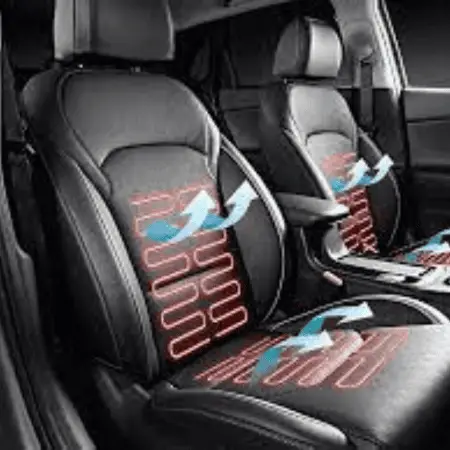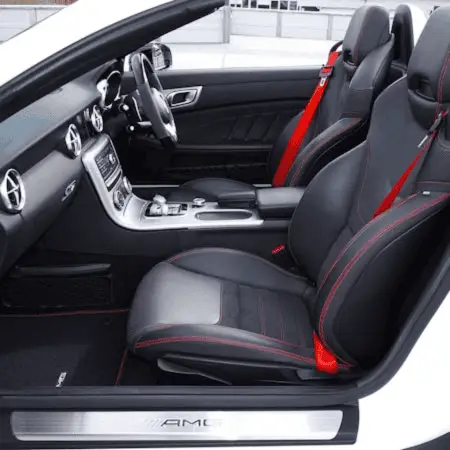If you’ve ever found yourself sweating uncomfortably during a scorching summer drive or experiencing that sticky feeling on your back after hours on the road, the concept of ventilated seats might pique your interest. In recent years, the automotive industry has witnessed a surge in the popularity of ventilated seats, promising a cooler and more comfortable driving experience. But are they worth the hype and the potential investment? In this article, I will help you find out “Are ventilated seats worth it?” So keep on reading…

What Are Ventilated Seats?
Ventilated seats are an advanced feature in vehicles designed to provide comfort to the driver and passengers by allowing air to circulate through the seating material, reducing sweat and sticking, particularly during warm weather.
These seats operate by pushing air through the seat fabric via small fans located within the seat, effectively cooling the surface and the occupant’s body.
My Recommendations
- CooCoCo Ventilated Cooling Car Seat Cushion
- Adjustable Temperature Ventilated Car Seat Cushion
- Snailax Cooling Seat Cover for Car
- Paffenery 12V-24V Ventilated Cooling Car Seat Cushion
- Zone Tech Black Cooling Car Seat Cushion
pros and cons of ventilated seats
Ventilated seats are a feature found in some vehicles that use air circulation to enhance passenger comfort, especially during warm weather or long drives. Here’s a breakdown of their pros and cons, using simple words:
Pros of Ventilated Seats
- Cooling Effect: The primary advantage is their ability to keep you cool. On hot days or during long drives, ventilated seats circulate air through the seat itself, helping to reduce sweat and maintain a comfortable temperature.
- Increased Comfort: Beyond just cooling, the air circulation can make sitting for long periods more comfortable, as it helps to prevent the stickiness and discomfort that can come from sweating.
- Health Benefits: For some, especially those who drive a lot, ventilated seats can offer health benefits by reducing the risk of skin irritation and discomfort that comes from sitting in a hot, humid environment for too long.
- Luxury Feel: Having ventilated seats in your vehicle can add a touch of luxury and sophistication, making your driving experience more pleasant.
- Better for Leather Seats: If your car has leather seats, ventilation helps to protect the material by keeping it cooler and reducing the amount of sweat and oils that can break down the leather over time.
Cons of Ventilated Seats
- Cost: Ventilated seats are often considered a premium feature, so cars equipped with them can be more expensive. Additionally, if they need repair, the cost can be higher than that for standard seats.
- Effectiveness Varies: The effectiveness of ventilated seats can vary depending on the vehicle model, the outside temperature, and how the ventilation system is designed. In some cases, they might not provide as much cooling as expected.
- Noise: Some people find that ventilated seats produce a slight noise due to the air circulation. While it’s usually not loud, it can be noticeable in a quiet vehicle.
- Maintenance: While not overly burdensome, ventilated seats can require more maintenance than standard seats. The ventilation system needs to be kept clean and free from blockages to work effectively.
- Energy Use: Ventilated seats require energy to operate. If your car is running on battery power, such as in electric vehicles, using ventilated seats can slightly reduce the vehicle’s overall range.
You May Find Helpful
- Will Vinegar Damage Car Paint? Potential Risks Of Using Vinegar
- 6 Reasons: Why Learners Fail Their Driving Test
- Is Driving Hard For Beginners? A Complete Guide
- Is It Safe To Drive Without Power Steering?

are ventilated seats the same as cooled seats
Ventilated seats and cooled seats are related but distinct features, and it’s common for the terms to be used interchangeably or confused. Here’s a simple explanation of the difference:
Ventilated Seats
Function: Ventilated seats work by allowing air to circulate through the seat material. A fan inside the seat draws air in and pushes it through the seat and backrest. This airflow helps to dissipate heat and moisture from the body, making the seating experience more comfortable, especially in warm conditions.
Primary Benefit: The main advantage is improved air circulation, which can reduce sweating and keep you feeling cooler.
Cooling Effect: The cooling effect mainly comes from the evaporation of sweat and the movement of air, rather than the air being cooled before it reaches you.
Cooled Seats
Function: Cooled (or air-conditioned) seats take the concept a step further by cooling the air before it circulates through the seat. This can involve various technologies, including small air conditioning units or thermoelectric devices within the seat itself.
Primary Benefit: Cooled seats provide a more pronounced cooling effect, actively lowering the surface temperature of the seat for immediate relief from heat.
Cooling Effect: These seats can make you feel cooler more quickly because they are designed to lower the temperature, not just increase air circulation.
Comparison
Effectiveness: Cooled seats are generally more effective at providing a cooling sensation, especially in very hot weather, because they actively cool the air. Ventilated seats, however, rely on air movement to create a cooling effect through evaporation and ventilation.
Complexity and Cost: Cooled seats are typically more complex and expensive than ventilated seats due to the additional technology required to cool the air. This complexity can also affect repair and maintenance costs.
Energy Consumption: Cooled seats can consume more energy than ventilated seats because of the need to cool the air, which can be a consideration in electric vehicles where battery efficiency is a concern.
While ventilated seats improve comfort through enhanced air circulation, cooled seats provide a more direct cooling effect by actively lowering the air temperature. Both aim to increase comfort in warm conditions, but they do so using different methods and with varying degrees of effectiveness.
are ventilated seats worth it
Deciding whether ventilated seats are worth it involves considering several factors based on your personal needs, preferences, and the climate you live in. Here’s a detailed explanation using simple words:
Is It Worth It?
Climate Consideration: If you live in a hot climate or have long, hot summers, ventilated seats can be a game-changer for comfort during those sweltering days.
Personal Preference: If you find yourself sweating a lot in the car or just want the added luxury and comfort, ventilated seats might be worth the investment for you.
Budget: Consider whether the added cost fits into your budget. If you’re deciding between essential features and ventilated seats on a tight budget, you might want to prioritize other features that are more important to you.
Whether ventilated seats are worth it depends on how much value you place on comfort, how much you’re willing to spend, and how often you find yourself wishing for a cooler seating experience during drives. If the benefits align with your needs and the drawbacks don’t deter you, ventilated seats can be a worthwhile addition to your vehicle.
Further Readings
- How To Clear Service Suspension System? Explained
- How To Start A Car With A Bad Crankshaft Sensor?
- Can You Drive With Bad Lifters? Explain In Detail
- Should I Wax My Car After Every Wash? Explained
conclusion
While ventilated seats represent an additional upfront cost and require some maintenance, the level of comfort and luxury they add to the driving experience can be well worth the investment for many. Considering the benefits and potential drawbacks, the decision ultimately comes down to individual preferences and the specific needs of your climate and lifestyle.
